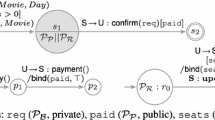Abstract
Getting agents to communicate requires translating the data structures of the sender (the source representation) to the format required by the receiver (the target representation). Assuming that there is a formal theory of the semantics of the two formats, which explains both their meanings in terms of a neutral topic domain, we can cast the translation problem as solving higher-order functional equations. Some simple rules and strategies apparently suffice to solve these equations automatically. The strategies may be summarized as: decompose complex expressions, replacing topic-domain expressions with source-domain expressions when necessary. A crucial issue is getting the required formal theories of the source and target domains. We believe it is sufficient to find partial formalizations that grow as necessary.
Similar content being viewed by others
References
J. L. Ambite, C. A. Knoblock, I. Muslea, and A. Philpot, “Compiling Source Descriptions for Efficient and Flexible Information Integration, ” Journal Intelligent Information Systems, vol. 16, no.2, pp. 149–187, 2001.
N. Ashish and C. A. Knoblock, “Semi-Automatic Wrapper Generation for Internet Information Sources, ” in Proceedings Second IFCIS Conference on Cooperative Information Systems (CoopIS), Charleston SC, 1997.
R. J. Bayardo, W. Bohrer, R. Brice, A. Cichocki, J. Fowler, A. Helal, V. Kashyap, T. Ksiezyk, G. Martin, M. Nodine, M. Rashid, M. Rusinkiewicz, R. Shea, C. Unnikrishnan, A. Unruh, and D. Woelk, “Infosleuth: Agent-Based Semantic Integration of Information in Open and Dynamic Environments, ” ACM SIGMOD' 97, ACM, pp. 195–206, 1997.
J. Bradshaw (ed.), Software Agents, AAAI Press/MIT Press, 1997.
A. Bundy, A. Stevens, F. van Harmelen, A. Ireland, and A. Smaill, “Rippling: A Heuristic for Guiding Inductive Proofs, ” Artificial Intelligence, vol. 62, no.2, pp. 185–253, 1993.
T. Finin, Y. Labrou, and J. Mayfield, “KQML as an Agent Communication Language, ” in J. Bradshaw (ed.), Software Agents, AAAI Press/MIT Press, 1997.
FIPA, Fipa acl Message Structure Specification, http://www.pa.org/specs/.pa00061/XC00061E.html., 2001.
FIPA, Fipa Communicative Act Library Specification, http://www.pa.org/specs/fipa00037/XC00037H.html., 2001.
D. Florescu, L. Raschid, and P. Valduriez, “A Methodology for Query Reformulation in Cis Using Semantic Knowledge, ” International Journal ofCooperative Information Systems, vol. 5, no.4, 1996.
J. A. Giampapa, M. Paolucci, and K. Sycara, “Agent Interoperation Across Multagent System Boundaries, ” in Proceedings Fourth International Conference on Autonomous Agents (Agents 2000), Association for Computing Machinery: New York, 2000.
J. Hammer, H. Garcia-Molina, J. Cho, R. Aranha, and A. Crespo, “Extracting Semistructured Information from the Web, ” in Proceedings Workshop on Management of Semistructured Data, Tucson AZ, 1997.
G. Huet and B. Lang, “Proving and Applying Program Transformations Expressed with Second-Order Patterns, ” Acta Informatica, vol. 11, pp. 31–55, 1978.
M. Klusch and K. Sycara, “Brokering and Matchmaking for Coordination of Agent Societies: A Survey, ” in A. Omicini, F. Zambonelli, M. Klusch, and R. Tolksdorf (eds.), Coordination of Internet Agents: Models, Technologies and Applications, Springer Verlag, 2001.
Y. Labrou, T. Finin, and Y. Peng, “The Current Landscape of Agent Communication Languages, ” IEEE Intelligent Systems, vol. 14, no.2, pp. 45–52, 1999.
D. L. Martin, A. J. Cheyer, and D. B. Moran, “The Open Agent Architecture: A Framework for Building Distributed Software Systems, ” Applied Artificial Intelligence, vol. 13, pp. 91–128, 1999.
J. Mayfield, Y. Labrou, and T. Finin, “Evaluation of KQML as an Agent Communication Language, ” in M. Wooldridge, J. P. Mueller, and M. Tambe (eds.), Intelligent Agents II: Agent Theories, Architectures, and Language, Volume 1037, Springer-Verlag Lecture Notes in AI, 1996.
T. Menzies, “Cost Benefits of Ontologies, ” Intelligence, vol. 10, no.3, pp. 27–32, 1999.
T. Milo and S. Zokar, “Using Schema Matching to Simplify Heterogenous Data Translation, ” in Proceedings Conference on Very Large Data Bases, pp. 122–133, 1998.
I. Muslea, S. Minton, and C. A. Knoblock, “Wrapper Induction for Semistructured, Web-Base Information Sources, ” in Proceedings Conference on Automated Learning and Discovery (CONALD), 1998.
Y. Papakonstantinou, H. Garcia-Molina, and J. Widom, “Object Exchange Across Heterogeneous Information Sources, ” in Proceedings Eleventh International Conference on Data Engineering, Taipei, pp. 251–260, 1995.
Y. Papakonstantinou, A. Gupta, H. Garcia-Molina, and J. Ullman, “A Query Translation Scheme for Rapid Implementation of Wrappers, ” in Proceedings DOOD Conference, pp. 161–186, 1995.
D. R. Smith, “Kids: A Semi-Automated Program Development System, ” IEEE Transactions on Software Engineering, vol. 16, no.9, pp. 1024–1043, 1990.
Y. Srinivas and R. Jüllig, “Specware: Formal Support for Composing Software, ” in B. Moeller (ed.), Proceedings Conference on Mathematics of Program Construction, LNCS 947, Springer-Verlag, pp. 399–422, 1995.
K. Sycara, M. Klusch, S. Widoff, and J. Lu, “Dynamic Service Matchmaking Among Agents in Open Information Environments, ” in Journal ACM SIGMOD Record, vol. 1, pp. 47–53, 1999.
K. Sycara, M. Paolucci, M. V. Velsen, and J. A. Giampapa, “The Retsina MAS Infrastructure, ” Technical Report, Robotics Institute, Carnegie Mellon University, CMU-RI-TR–01–05, 2001.
J. D. Ullman, Principles of Database and Knowledge-Base Systems, Computer Science Press, 1988.
J. D. Ullman, “Information Integration Using Logical Views, ” in Proceedings 6th International Conference on Database Theory (ICDT-97), Lecture Notes in Computer Science, Springer-Verlag, pp. 19–40, 1997.
Author information
Authors and Affiliations
Rights and permissions
About this article
Cite this article
Burstein, M., McDermott, D., Smith, D.R. et al. Derivation of Glue Code for Agent Interoperation. Autonomous Agents and Multi-Agent Systems 6, 265–286 (2003). https://doi.org/10.1023/A:1022975408458
Issue Date:
DOI: https://doi.org/10.1023/A:1022975408458




